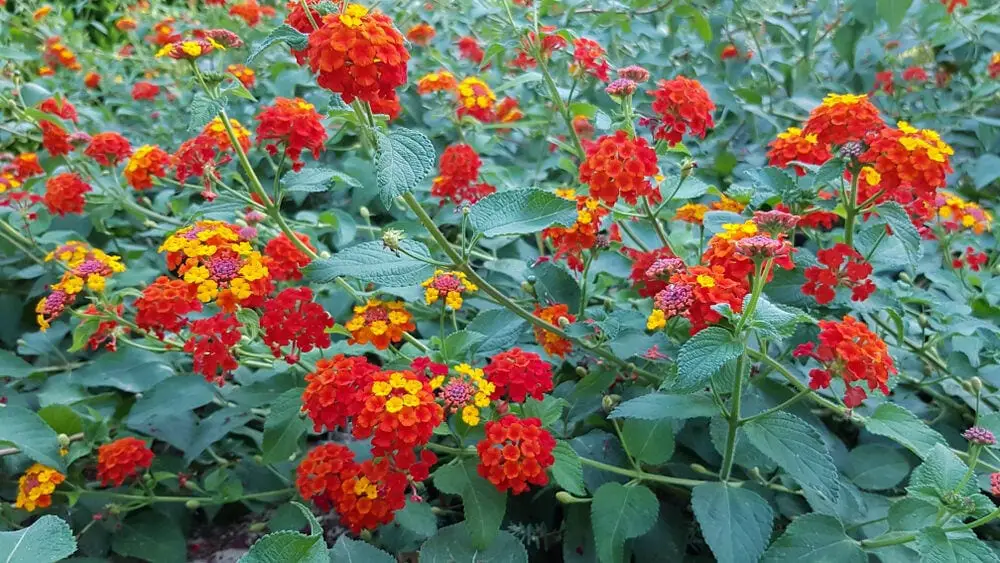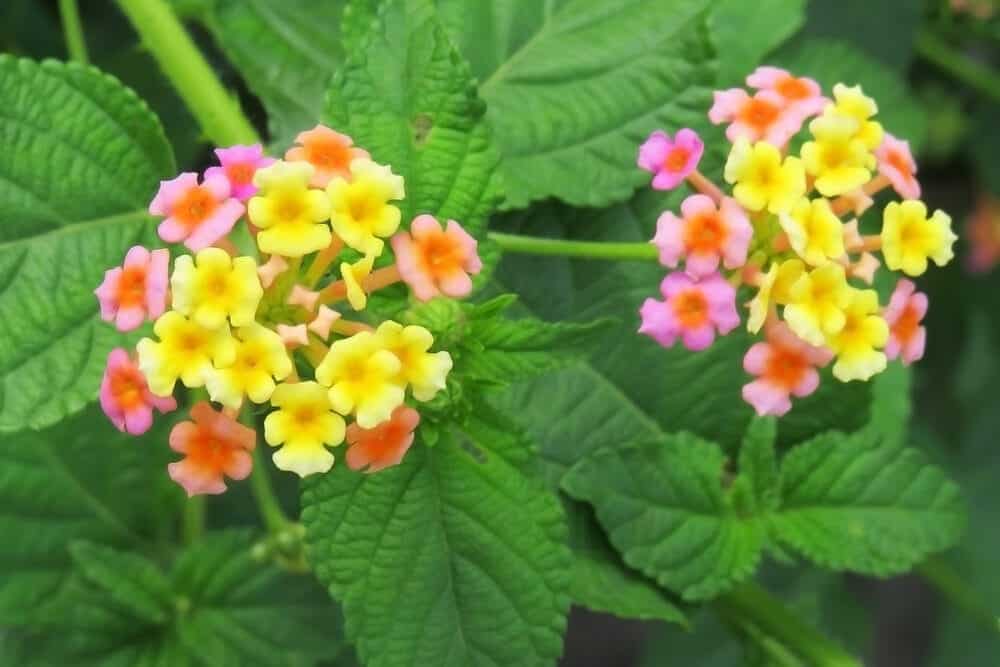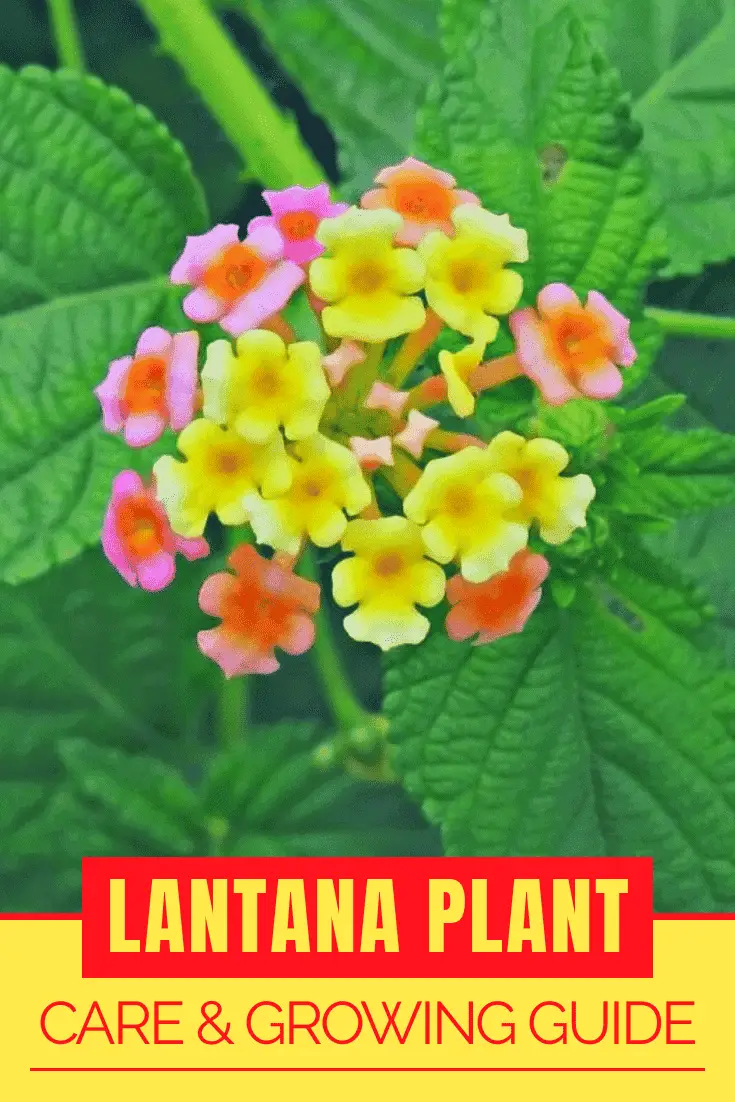This colorful plant makes a great addition to any garden or front yard.
It’s most beautiful in the height of spring when it’s multicolored flowers bloom. However, if you get close enough to smell these flowers, you’ll notice this plant gives off a peppery scent. Don’t sneeze!
Lantana Plant Care & Growing Guide
1. Light requirements
Full sun is the best type of sun needed for the lantana bush to thrive. Make sure that it is planted in an area where it can receive more than six hours of direct sunlight a day. If this plant is indoors, then it needs to be behind a window that gets full sun, or you can place it on the porch and bring it in at night. But if the sun comes with intense heat, then shelter it and give it a lot of indirect light.
2. Water
Despite what many lantana bush owners may think, this plant was built for droughts, and it does not like to be watered often, especially after it reaches full maturity. It needs to be watered just once a week, depending on how warm the weather is. But always choose to water it less than more.
3. Climate and temperature
Lantana bushes are a sturdy winter plant that can weather the cold, but it enjoys the warmth. It lives and thrives in hardiness zone 8 to 11, so make sure that the area where you live does not experience many intensely hot days or heatwaves. Moderate heat is best. But some types of lantana bushes die in the cold winter months.
4. Soil
The best type of soil to plant the lantana bush in is slightly acidic soil. The soil should also drain well and not allow water to build up since this plant type is built for droughting periods. But if you don’t have slightly acidic soil, this plant can adapt to any ph that is not too extreme. You may not see as many flowers on it come springtime.

5. How to propagate the Lantana bush
When the Lantana bush flowers, small berries also come out. These berries contain seeds that you can use to plant more bushes. But if you want to use cuttings, then cut a four-inch piece of the stem off of the bush and remove large and medium leaves and repot the cutting. Using a potting soil that promotes root growth will help improve its chances of growing strong even more. Leave the new plant inside of your home until the middle of spring but keep it in a space where the bush can receive full sunlight.
6. Height and spread
This plant does well both indoors and outdoors, if it receives full sunlight. It’s height usually grow up two to four feet, sometimes six feet if ideal conditions are met, and if it’s a few years old. Since it is a bush, it’s width can vary, from 1 ½ foot to 4 feet, depending on how often it is trimmed.
7. Does the Lantana bush have flowers, and how do I make them bloom?
The lantana bush is known for its multicolored flowers, from red to orange, purple, and yellow. The flowers die every year around the wintertime and reach their full bloom towards the end of spring. If you want your Lantana bush to flower, then just care for it well. It flowers every year in the spring. The flower will last from spring to late fall.
8. Trimming the Lantana Bush
The best time to trim this bush in the middle of spring, but you can do it in the winter as well if the plant is looking gnarly. But don’t do it in the fall, because losing stems and leaves can make its winter hardiness fade and the plant will suffer. When it is time to trim, cut away old growth of large leaves and flowers, so more energy can be devoted to younger smaller growth. Trim it over the season and not all at once, to prevent shock.

Is the Lantana bush poisonous?
The berries of the lantana bush are incredibly toxic and can kill some animals like pets or even young children. The first few symptoms of lantana berry poisoning are vomiting, nausea, and troubled and shallow breathing. If ingested, the person affected must rush to the hospital immediately. Even touching the leaves for too long can cause severe skin irritation and itchiness. Do not have this plant anywhere near small children.
Can the Lantana bush grow in water?
No, too much water can slowly kill the Lantana plant. This bush was cultivated to withstand droughts and long cold winters. Too much water during the wintertime can cause root rot and mold on stems. If it is submerged in water, it won’t last until spring.
Common Plant Diseases and pests
Powdery mildew is one common fungal disease that leaves a white coating on its leaves. If left on for too long, the mildew can break down the structure of the leaves and cause them to die. If you remove it when you see it, then your plants should be fine. Just make a mixture of baking soda and water and wipe down all of the leaves that have the mildew on it. Do not wipe the flowers.
Whiteflies like to bite into the flesh of the lantana plants and suck out the sap, which damages the stems and leaves. If too many whiteflies attack the plant, it could die in a matter of weeks. Besides eating the plant, the adults and the larvae leave behind a sticky residue called honeydew, which attracts black fungus. To fight off these ugly little bugs, you have to wash them off with water or with a hose, then spray the plant with insecticidal soap. Do this every week until they’re all gone.
Conclusion
- This succulent is a popular treat among elephants.
- On a single plant could be more than four colors of flowers
- The Lantana bush can stand droughts and doesn’t like too much water, especially after it reached maturity.
- This bush is known to attract a lot of bees, hummingbirds, and even butterflies, because of its many flowers.
- The many colors of the lantana bush make it a must-have if you want a beautiful garden.

Victoria is the owner and main author of hobby plants. She loves spending her free time in her garden planting and taking care of her plants. Victoria hopes you enjoy the content here!
![Mother Of Thousands Plant [Complete Plant Care Guide] Mother Of Thousands Plant [Complete Plant Care Guide]](https://www.hobbyplants.com/wp-content/uploads/2022/07/mother-of-thousands-plant-300x158.jpg)
![Majesty Palm Plant Care: [Complete Beginner's Guide] Majesty Palm Plant Care: [Complete Beginner's Guide]](https://www.hobbyplants.com/wp-content/uploads/2022/08/majesty-palm-care-300x158.jpg)
![Exotic Angel Plant Care: [Complete Beginner's Guide] Exotic Angel Plant Care: [Complete Beginner's Guide]](https://www.hobbyplants.com/wp-content/uploads/2022/08/exotic-angel-plant-care-300x158.jpg)
![Snow White Waffle Plant: [Complete Care Guide] Snow White Waffle Plant: [Complete Care Guide]](https://www.hobbyplants.com/wp-content/uploads/2022/08/snow-white-waffle-plant-300x158.jpg)
![Waffle Plant Care: [Complete Beginner's Guide] Waffle Plant Care: [Complete Beginner's Guide]](https://www.hobbyplants.com/wp-content/uploads/2022/08/waffle-plant-300x158.jpg)
![Bird Of Paradise Plant Care: [Complete Beginner's Guide] Bird Of Paradise Plant Care: [Complete Beginner's Guide]](https://www.hobbyplants.com/wp-content/uploads/2022/08/bird-of-paradise-plant-300x158.jpg)
![Purple Passion Plant Care: [Complete Beginner's Guide] Purple Passion Plant Care: [Complete Beginner's Guide]](https://www.hobbyplants.com/wp-content/uploads/2022/08/purple-passion-plant-care-300x158.jpg)
![China Doll Plant Care: [Complete Beginner's Guide] China Doll Plant Care: [Complete Beginner's Guide]](https://www.hobbyplants.com/wp-content/uploads/2022/09/china-doll-plant-care-300x158.jpg)
![Polka Dot Plant Care: [Complete Beginner's Guide] Polka Dot Plant Care: [Complete Beginner's Guide]](https://www.hobbyplants.com/wp-content/uploads/2022/09/polka-dot-plant-300x158.jpg)
![Mona Lisa Lipstick Plant Care: [Complete Beginner's Guide] Mona Lisa Lipstick Plant Care: [Complete Beginner's Guide]](https://www.hobbyplants.com/wp-content/uploads/2022/09/lipstick-plant-mona-lisa-300x158.jpg)
![Yucca Cane Plant Care: [Complete Beginner's Guide] Yucca Cane Plant Care: [Complete Beginner's Guide]](https://www.hobbyplants.com/wp-content/uploads/2022/09/yucca-cane-plant-care-300x158.jpg)
![Bush On Fire Croton Plant Care: [Complete Beginner's Guide] Bush On Fire Croton Plant Care: [Complete Beginner's Guide]](https://www.hobbyplants.com/wp-content/uploads/2022/09/bush-on-fire-croton-300x158.jpg)